
The House of Bonaparte is a former imperial and royal European dynasty of Italian (Genoese) origin. It was founded in 1804 by Napoleon I, the son of Corsican nobleman Carlo Buonaparte and Letizia. Napoleon was a French military leader who rose to power during the French Revolution and who, in 1804, transformed the First French Republic into the First French Empire, five years after his coup d'état of November 1799. Napoleon and the Grande Armée had to fight against every major European power and dominated continental Europe through a series of military victories during the Napoleonic Wars. He installed members of his family on the thrones of client states, expanding the power of the dynasty.

Pope Clement VII was spiritual head on earth of the Catholic Church and ruler of the Papal States from 19 November 1523 to his death on 25 September 1534. Deemed "the most unfortunate of the popes", Clement VII's reign was marked by a rapid succession of political, military, and religious struggles—many long in the making—which had far-reaching consequences for Christianity and world politics.

Pisa is a city and comune in Tuscany, central Italy, straddling the Arno just before it empties into the Ligurian Sea. It is the capital city of the Province of Pisa. Although Pisa is known worldwide for its leaning tower, the city of over 91,104 residents contains more than 20 other historic churches, several medieval palaces, and various bridges across the Arno. Much of the city's architecture was financed from its history as one of the Italian maritime republics.

Giuliano di Lorenzo de' Medici KG was an Italian nobleman, the third son of Lorenzo the Magnificent, and a ruler of Florence.

The Mausoleum of Hadrian, usually known as Castel Sant'Angelo, is a towering cylindrical building in Parco Adriano, Rome, Italy. It was initially commissioned by the Roman Emperor Hadrian as a mausoleum for himself and his family. The building was later used by the popes as a fortress and castle, and is now a museum. The structure was once the tallest building in Rome.

The Sack of Rome, then part of the Papal States, followed the capture of the city on 6 May 1527 by the mutinous troops of Charles V, Holy Roman Emperor during the War of the League of Cognac. Rioting over unpaid salaries, the German Landsknechte, many of whom were Protestant, together with Spanish soldiers and Italian mercenaries, entered the city of Rome and immediately began looting, slaying and holding citizens for ransom. The sack debilitated the League of Cognac, an alliance formed by France, Milan, Venice, Florence and the Papacy against Charles V. Pope Clement VII took refuge in Castel Sant'Angelo after the Swiss Guard were annihilated in a delaying rearguard action, where he remained until a ransom was paid to the pillagers. By February 1528 lack of food and an outbreak of plague led to the armies abandoning the city, whose population had dropped from 55,000 to 10,000. Benvenuto Cellini, eyewitness to the events, described the sack in his works.

Francesco Guicciardini was an Italian historian and statesman. A friend and critic of Niccolò Machiavelli, he is considered one of the major political writers of the Italian Renaissance. In his masterpiece, The History of Italy, Guicciardini paved the way for a new style in historiography with his use of government sources to support arguments and the realistic analysis of the people and events of his time.

Borghese is the surname of a princely family of Italian noble and papal background, originating as the Borghese or Borghesi in Siena, where they came to prominence in the 13th century and held offices under the commune. During the 16th century, the head of the family, Marcantonio, moved to Rome, where they rose in power and wealth following the election of his son Camillo as Pope Paul V in 1605. They were one of the leading families of the Black Nobility and maintain close ties to the Vatican.

The Passetto di Borgo, or simply Passetto, is an elevated passage that links the Vatican City with the Castel Sant'Angelo. It is an approximately 800-metre-long (2,600 ft) corridor, located in the rione of Borgo. It was erected in 1277 by Pope Nicholas III, but parts of the wall were built by Totila during the Gothic War.

Corsini is the name of a Florentine princely family.

San Miniato is a town and comune in the province of Pisa, in the region of Tuscany, Italy.

The Siege of Florence took place from 24 October 1529 to 10 August 1530, at the end of the War of the League of Cognac. At the Congress of Bologna, the Medici Pope Clement VII and Emperor Charles V agreed to restore the Medici in Florence. A large Imperial and Spanish army under Philibert of Châlon, Prince of Orange and Pier Maria III de' Rossi surrounded the city, and, after a siege of nearly ten months, captured it, overthrowing the Republic of Florence and installing Alessandro de' Medici as the ruler of the city.

Niccolò Ridolfi was an Italian cardinal.

Filippo Strozzi the Younger was a Florentine banker, and the most famous member of the Strozzi family in the Renaissance. He is best remembered as a tragic hero and defender of the lost Florentine republic against the Medici dukes – yet this is almost entirely a nineteenth-century fiction of nationalist historians and dramatists. He had been one of the staunchest supporters of the House of Medici in Florence and Rome.
Raffaello da Montelupo, born Raffaele Sinibaldi, was a sculptor and architect of the Italian Renaissance, and an apprentice of Michelangelo. He was the son of another Italian sculptor, Baccio da Montelupo. Both father and son are profiled in Vasari's Le Vite delle più eccellenti pittori, scultori, ed architettori.

Lucrezia Maria Romola de' Medici was an Italian noblewoman, the eldest daughter of Lorenzo de' Medici and Clarice Orsini and mother of Maria Salviati and Giovanni Salviati. Her portrait was considered as the baby Jesus in Our Lady of the Magnificat of Sandro Botticelli.

Dr. Joshua F. Drake is a musicologist and hymnist and former faculty member at Grove City College in Grove City, Pennsylvania. His research, writing and presentations primarily analyze the structure of 15th century Latin Christian motets, which are a category of choral musical compositions. Drake is notable for his research and papers that vehemently challenge commonly held views regarding the complex and often misunderstood relationship between words and music in motets of the late 15th century, as well as his discoveries related to the origins of the Buonaparte family. He also served on the editorial advisory board for "The Quad" Magazine.

This timeline lists important events relevant to the life of the Italian diplomat, writer and political philosopher Niccolò di Bernardo dei Machiavelli (1469–1527).

Giovanni di Bernardo Rucellai was an Italian humanist, poet, dramatist and man of letters in Renaissance Florence, in Tuscany, Italy. A member of a wealthy family of wool merchants and one of the richest men in Florence, he was cousin to Pope Leo X and linked by marriage to the powerful Strozzi and de' Medici families. He was born in Florence, and died in Rome. He was the son of Bernardo Rucellai (1448–1514) and grandson of Giovanni di Paolo Rucellai (1403–1481). He is now remembered mostly for his poem Le Api, one of the first poems composed in versi sciolti to achieve widespread acclaim.

Orazio di Giampaolo Baglioni was an Italian lord and condottiero. He took over command of Giovanni de' Medici's Black Bands after his death in 1526. Pope Clement VII held him responsible for the unrest in Perugia and imprisoned him in Castel Sant'Angelo in Rome. However, during the siege of Rome in 1527 prior to its sack, Clement put Orazio in charge of the city's defences. He died in an ambush during the Siege of Naples.




















